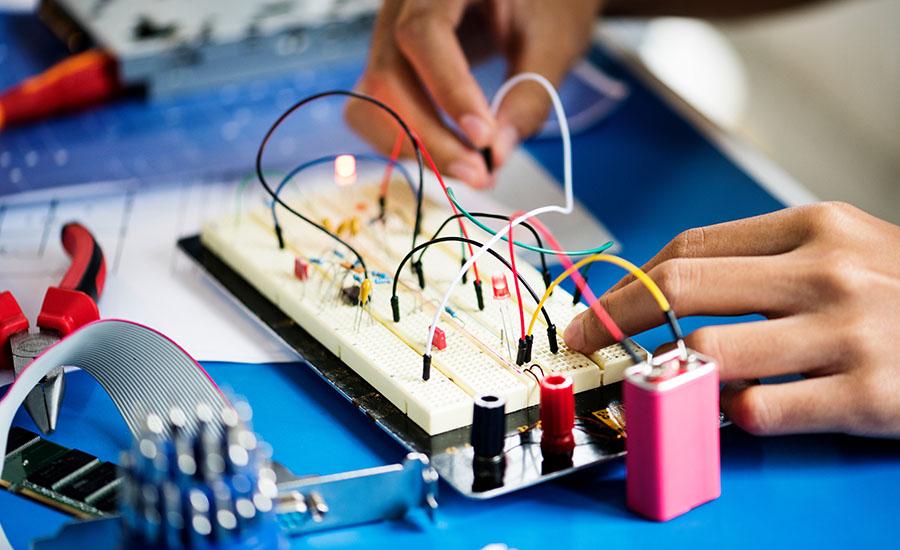This lesson plan will allow students to explore the use of a PhET simulation in creating a series and parallel circuit, then apply this knowledge in creating a real circuit. Students will also learn
Electricity and magnetism are fundamental to the workings of nearly every gadget, appliance, vehicle, and machine we use. This great 6th Grade lesson covers magnetic fields where students will be able
Lesson Two of Four: This lesson will help to show students there are lots of possibilities when building robots and students will be able to create their own prototype.
Introducing how EdScratch programming works with the Edison Robots. Activities and ideas linked in the lesson.
Students are introduced to a project that asks them to use classroom materials to create a new form of vision technology. Students review how the eye works, create a plan, and share that plan with
Engage your students by learning about the Ferris Wheel and constructing a ferris wheel in a collaborative assignment. The informational text of Mr. Ferris and His Wheel is linked for your convenience
This design challenge is broken up into four parts, this is part four. This lesson will focus on sharing each group’s design and discussing their iterations (Share). In order to successfully execute
Students will use science and engineering practices to design and build a parachute out of everyday items. The parachute must be able to carry a metal washer to a specific target on the ground while
Students will learn about forces and motion by building a straw rocket. They will measure how far their rocket flies and then build a second rocket to see if they can make it go farther.
Go through different STEM, reading, and writing activities with Roz and her friends in The Wild Robot. Students will problem solve, participate in discussions, and learn about artificial intelligence
From this lesson, students will discover how friction affects how things move. This is an excellent activity that will allow students to be creative and build a marble run to show friction. This
Mad For Magnets is a lesson plan for K-4th grades. Scholars will learn about magnets, how they attract and repel, north and south poles to apply to the assigned challenge. Scholars will design and
In this lesson, students will embark on an exciting exploration of greenhouses. They will discover how greenhouses provide a special environment for plants to grow by letting in sunlight and trapping
This lesson will allow students to learn more about 3D printing design and the engineering process. Students will brainstorm different needs in their community and people who could benefit from
Students will learn about how energy can be transferred from wind into electricity. Students will work in groups to design a wind turbine, research how turbines and generators work, build a turbine
Let's talk about waste! Situation: Many items are thrown in the trash every day at school. As a class, track data to determine what the top 5 most frequently discarded items are on your campus
In this problem-solving lesson, students learn about our landfills and come up with a solution using robots! Did you know, according to data from Waste Business Journal, American landfills only have
In this hands-on lesson, students collaborate with partners to create a game in which they practice their multiplication and division facts. This is an engaging way for students to develop fact
In this hands-on lesson, students identify Newton’s Laws of Motion, analyze the difference between force and motion, compare balloon car designs with group mates and demonstrate how to design and test
This is a lesson on measurement and problem solving! The king needs to find a birthday present for the queen, but what do you get for someone who has everything? He decides to build her a bed (before
In this lesson, students will be introduced to the phenomenon of paper/air pressure rocketry. Students will make a memorable and hands-on connection with the transfer of energy when they create and
Could Iron Man actually survive a superhero landing? In this lesson, students follow the engineering design process to create a "suit" for an egg to protect it from being dropped on the ground. They
Featured Lesson Plans
Check out these notable lesson plans.

In this outstanding lesson, students will explore circuitry through working collaboratively to build a working floor piano out of simple materials. Students explore the engineering design process by

STEM in the Garden- Wild Bee Hotel
Third grade students will apply their knowledge of the significance of bee pollination by designing and creating a Wild Bee Hotel in a collaborative group which will incorporate literacy, mathematical

In this outstanding lesson, students will apply their knowledge of how natural and human-caused changes to habitats or climate can impact our world in a stop motion film. The lesson covers a Science


